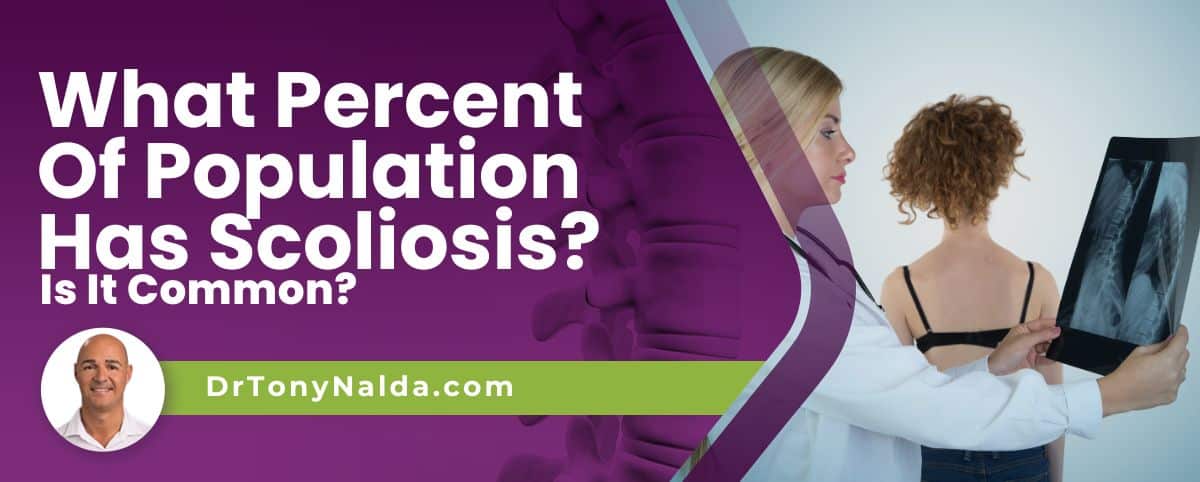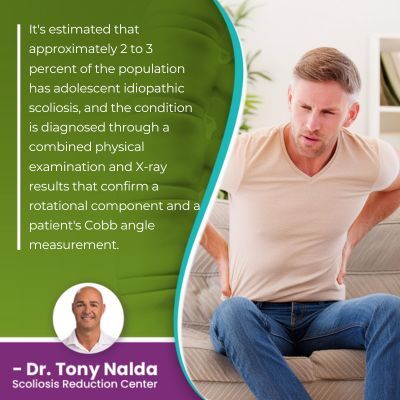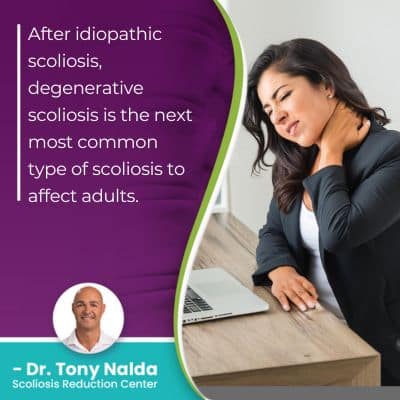What Percent Of Population Has Scoliosis? Is It Common?

While most people have heard of scoliosis, many don't understand its prevalence. Scoliosis screening used to be conducted in schools across the States, but that has since changed, so it's more important than ever to spread awareness that can lead to early diagnosis and treatment.
It's estimated that 2 to 3 percent of the population has scoliosis, meaning between 6 and 9 million people in the United States alone. Scoliosis affects all ages but is the most prevalent in adolescents, and scoliosis is the leading spinal condition among school-aged children.
While scoliosis affects all ages, symptoms, and treatment needs vary based on patient age, so along with the prevalence of scoliosis, let's explore the main differences between childhood and adult scoliosis.
Table of Contents
Symptoms of Childhood Scoliosis
Scoliosis can affect babies born with the condition as congenital scoliosis, infantile scoliosis, early-onset juvenile scoliosis, and adolescent idiopathic scoliosis.
Adolescent idiopathic scoliosis is diagnosed between the ages of 10 and 18 and is the most prevalent type overall.
As a progressive condition, the nature of scoliosis is to get worse over time, and this means the size and twist of the unnatural spinal curve is going to get worse over time, so where a child's scoliosis is at the time of diagnosis doesn't mean that's where it will stay.
Scoliosis ranges from mild scoliosis to moderate scoliosis, severe and very severe scoliosis, and this is also the condition's progressive line.
When a child develops scoliosis, the symptoms can be subtle, especially when mild.
In many patients, the earliest signs of scoliosis in children are uneven shoulders and hips, and additional postural changes can include:
- Uneven shoulder blades
- Development of a rib cage arch
- An uneven waistline
- Arms and legs that hang at different lengths
These postural changes occur because of how the uneven forces of scoliosis disrupt the body's overall symmetry.
In addition to postural changes, disruptions to balance, coordination, and gait are also common.
As adolescents are in the stage of puberty, characterized by rapid and unpredictable growth spurts, and progression is triggered by growth, this age group is the most at risk for rapid-phase progression.
Treatment Options for Adolescent Idiopathic Scoliosis
 It's estimated that approximately 2 to 3 percent of the population has adolescent idiopathic scoliosis, and the condition is diagnosed through a combined physical examination and X-ray results that confirm a rotational component and a patient's Cobb angle measurement.
It's estimated that approximately 2 to 3 percent of the population has adolescent idiopathic scoliosis, and the condition is diagnosed through a combined physical examination and X-ray results that confirm a rotational component and a patient's Cobb angle measurement.
A patient's Cobb angle measurement is what condition severity is based on; the higher a Cobb angle, the further out of alignment the spine is, and the more severe the condition.
When treating adolescents with scoliosis, because of the constant trigger of growth, a focus of treatment is to achieve a significant curvature reduction and hold it there throughout growth.
Conservative Nonsurgical Scoliosis Treatment
Here at the Scoliosis Reduction Center, the treatment approach is modern conservative nonsurgical treatment, with proven results.
As scoliosis is a structural condition, it has to be impacted on a structural level, and this is worked towards through condition-specific chiropractic care that involves a series of techniques and manually adjustments that can realign the spine by adjusting the position of the curve's most-tilted vertebrae.
Once I have impacted conditions on a structural level, the focus of treatment shifts to increasing core strength so the spine's surrounding muscles can optimally support and stabilize the spine, and this can involve physical therapy and scoliosis-specific exercises.
Corrective bracing is also particularly effective on growing spines so is a regular facet of treatment for childhood scoliosis.
Corrective bracing can help by pushing the spine into a corrective position, complementing the effects of other treatment disciplines applied simultaneously.
Rehabilitation is the final and ongoing phase of treatment; as a progressive condition, there is no curing scoliosis, but it can be highly treatable, so scoliosis treatment is more about managing an ongoing condition for the best quality of life.
Rehabilitation can involve continued chiropractic care and the prescription of scoliosis-specific exercises that can easily be performed from home.
Symptoms of Adult Scoliosis
The rate of scoliosis actually increases among the aging population, and this is due to spinal degeneration. Studies show rates of scoliosis in adults of between 12 and 20 percent of the population, and rates of scoliosis in adults over the age of 60 can affect as much as 68 percent of the population.
After idiopathic scoliosis, degenerative scoliosis is the next most common type of scoliosis to affect adults.
Degenerative scoliosis is caused by natural age-related spinal degeneration, and this most often starts in the spine's intervertebral discs as they lose fluid, change shape, and impact the position of vertebrae attached to the disc in between.
Adults experience scoliosis differently, and the main difference is pain.
Compression and Back Pain
Scoliosis doesn't become a compressive condition until skeletal maturity has been reached, and it's compression of the spine and its surrounding muscles and nerves that causes the majority of condition-related pain.
For children and adolescents who are still growing, the spine is constantly lengthening, and this motion counteracts the compressive force of the unnatural spinal curve, so this is why scoliosis isn't commonly painful for children, which can be a barrier to early detection.
For adults, however, it's back pain and, more often, pain that radiates into the extremities that brings them in for a diagnosis and treatment, and the unfortunate reality is that had these adults known about their conditions earlier and sought treatment earlier, their spines would be in far better shape.
Most of my patients here at the Center have moderate scoliosis, and that's because it's common that the symptoms of scoliosis don't become noticeable until it's progressed from mild to moderate.
 So for adults, pain is the main symptom, along with postural changes such as a prominent lean to one side that's more noticeable when in a forward bend position.
So for adults, pain is the main symptom, along with postural changes such as a prominent lean to one side that's more noticeable when in a forward bend position.
For adults, the treatment focus is also on achieving a curvature reduction, but more so on reducing the size of the scoliotic curve back to where it was prior to becoming painful, and a larger focus is on increasing the spine's stability.
As scoliosis progresses and the spine degenerates further, the spine becomes increasingly unstable and unbalanced.
Condition-specific chiropractic care and physical therapy can work towards reducing the size of the curve and increasing the spine's support and stability through increasing core strength.
Pain management can include pain medications, a variety of therapies, and the effects of treatment as curves are reduced back to where they were before becoming painful and spines are better supported and more stable.
Different Types of Scoliosis
There are also additional types of scoliosis with their own rates.
The most common type of scoliosis is idiopathic scoliosis, and this type accounts for approximately 80 percent of known diagnosed cases, and the remaining 20 percent consist of condition types with known causes: neuromuscular scoliosis, congenital scoliosis, and degenerative scoliosis, which we've already discussed.
Neuromuscular scoliosis is caused by the presence of a larger neuromuscular condition such as cerebral palsy, muscular dystrophy, or spina bifida, and the rates of neuromuscular scoliosis vary with different neuromuscular conditions:
- People with cerebral palsy in more than two limbs have an incidence of scoliosis of 25 percent
- People with myelodysplasia have a 60-percent incidence of scoliosis
- Spinal muscular atrophy patients have an incidence of 67 percent
Congenital scoliosis affects babies born with the condition due to a malformed spine that develops in utero: approximately 1 in 10,000.
And, as discussed, the rate of scoliosis in adults increases with age due to spinal degeneration and the cumulative effect of certain lifestyle choices: carrying excess weight, leading a sedentary lifestyle, chronic poor posture, repeatedly lifting heavy objects incorrectly, and consuming excessive amounts of alcohol and/or smoking.
Conclusion
While scoliosis is most commonly diagnosed in children, and is most often diagnosed during adolescence, the actual rate of scoliosis increases with age, and as the leading spinal condition affecting school-aged children, scoliosis warrants awareness.
While treatment results can never be guaranteed, knowing the condition's early signs can lead to early detection, which when met with a proactive treatment response, is associated with treatment success.
As a progressive condition, the best time to start scoliosis treatment is always now so curve progression can be prevented; the goal of proactive treatment is to stop mild scoliosis or moderate scoliosis from becoming severe scoliosis or very severe scoliosis.
The spine gets increasingly rigid and less responsive to treatment the more it progresses, so there are a number of benefits to starting treatment while conditions are at their mildest: early in their progressive line.
And while having a family history of scoliosis is considered a risk factor, scoliosis isn't considered a hereditary spinal condition; it's considered to be familial.
An abnormal lateral curvature of the spine doesn't have to limit a person's life; people can still thrive with scoliosis, particularly when scoliosis patients are diagnosed early and the initial diagnosis is responded to proactively.
The nature of scoliosis, regardless of type, is to get progressively worse, so addressing scoliosis cases with a conservative treatment plan can mean helping patients avoid the need for invasive surgery in the future.
Dr. Tony Nalda
DOCTOR OF CHIROPRACTIC
After receiving an undergraduate degree in psychology and his Doctorate of Chiropractic from Life University, Dr. Nalda settled in Celebration, Florida and proceeded to build one of Central Florida’s most successful chiropractic clinics.
His experience with patients suffering from scoliosis, and the confusion and frustration they faced, led him to seek a specialty in scoliosis care. In 2006 he completed his Intensive Care Certification from CLEAR Institute, a leading scoliosis educational and certification center.
About Dr. Tony Nalda
 Ready to explore scoliosis treatment? Contact Us Now
Ready to explore scoliosis treatment? Contact Us Now





